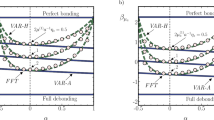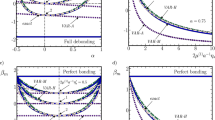Abstract
The elastic properties of dilute solid suspensions with imperfectly bonded inclusions of ellipsoidal shape are estimated. The imperfect bonding is regarded as a sharp interface across which the displacement jumps in proportion to the surface traction. Elastic compliances of the matrix and inclusion phases can exhibit arbitrary anisotropy while that of the bonding exhibits an anisotropy that depends on the interface normal only. A variational framework is employed to generate pairs of elementary bounds, asymptotically exact results, and approximations for the effective elasticity tensor. Each member of the pair differs in the way the bonding compliance is averaged over the interfacial surface: an ‘arithmetic’ mean in one case and a ‘harmonic’ mean in the other case. The results are used to infer the most convenient approximation for a given range of material parameters.
Similar content being viewed by others
Data Availability
No datasets were generated or analysed during the current study.
References
Dinzart, F., Sabar, H.: New micromechanical modeling of the elastic behavior of composite materials with ellipsoidal reinforcements and imperfect interfaces. Int. J. Solids Struct. 108, 254–262 (2017)
Gallican, V., Idiart, M.I.: Improved estimates for the elastic properties of dilute composites with imperfect interfacial bondings of moderate anisotropy. Meccanica 58, 1799–1808 (2023)
Gallican, V., Zecevic, M., Lebensohn, R.A., Idiart, M.I.: The elastic properties of dilute solid suspensions with imperfect interfacial bonding: variational approximations versus full-field simulations. J. Elast. 153, 373–398 (2023)
Gallican, V., Zecevic, M., Lebensohn, R.A., Idiart, M.I.: The elastic properties of fiber-reinforced materials with imperfect interfacial bondings: variational approximations versus full-field simulations. Submitted
Hashin, Z.: Thermoelastic properties of fiber composites with imperfect interface. Mech. Mater. 8, 333–348 (1991)
Hashin, Z.: Thermoelastic properties of particulate composites with imperfect interface. J. Mech. Phys. Solids 39, 745–762 (1991)
Hashin, Z.: Extremum principles for elastic heterogeneous media with imperfect interfaces and their application to bounding of effective moduli. J. Mech. Phys. Solids 40, 767–781 (1992)
Lipton, R., Vernescu, B.: Variational methods, size effects and extremal microgeometries for elastic composites with imperfect interface. Math. Models Methods Appl. Sci. 5, 1139–1173 (1995)
Mardsen, J.E., Hughes, T.J.R.: Mathematical Foundations of Elasticity. Dover Publications Inc., New York (1983)
Nazarenko, N., Stolarski, H.: Energy-based definition of equivalent inhomogeneity for various interphase models and analysis of effective properties of particulate composites. Composites, Part B, Eng. 94, 82–94 (2016)
Othmani, Y., Delannay, L., Doghri, I.: Equivalent inclusion solution adapted to particle debonding with a non-linear cohesive law. Int. J. Solids Struct. 48, 3326–3335 (2011)
Ponte Castañeda, P., Suquet, P.: Nonlinear composites. Adv. Appl. Mech. 34, 171–302 (1998)
Qu, J.: The effect of slightly weakened interfaces on the overall elastic properties of composite materiales. Mech. Mater. 14, 269–281 (1993)
Suquet, P.: Plasticité et Homogénéisation. Ph.D. Thesis, Université Pierre et Marie Curie, Paris (1982)
Willis, J.R.: Elasticity theory of composites. In: Hopkins, H.G., Sewell, M.J. (eds.) Mechanics of Solids, the Rodney Hill 60th Anniversary Volume, pp. 653–686. Pergamon, Elmsford (1982)
Zecevic, M., Bennett, K.C., Luscher, D.J., Lebensohn, R.A.: New self-consistent homogenization for thermo-elastic polycrystals with imperfect interfaces. Mech. Mater. 155, 103651 (2021)
Acknowledgements
The work was supported by the Air Force Office of Scientific Research (U.S.A.) under award number FA9550-19-1-0377 and by the Universidad Nacional de La Plata (Argentina) through grant I-2019-247.
Author information
Authors and Affiliations
Contributions
M.I. and V.G. carried out the research. M.I. wrote the manuscript. All authors reviewed the manuscript.
Corresponding author
Ethics declarations
Competing interests
The authors declare no competing interests.
Additional information
Publisher’s Note
Springer Nature remains neutral with regard to jurisdictional claims in published maps and institutional affiliations.
Appendices
Appendix A: Some Useful Identities for Ellipsoidal Inclusions
-
1.
The identity
$$\begin{aligned} \ell ^{-1}\langle \overline{{\mathbf {x}}}\otimes {\mathbf {n}}\rangle ^{(1,2)} = {\mathbf {I}} \end{aligned}$$(82)follows from the sequence of identities
 (83)
(83)The third identity follows from the change of variables
 , while the last identity follows from the fact that the integral is an isotropic symmetric function of the symmetric tensor \({\mathbf {A}}\), that it therefore shares the same eigenvectors of \({\mathbf {A}}\), and that it therefore has eigenvalues \(e_{i}\) given by
, while the last identity follows from the fact that the integral is an isotropic symmetric function of the symmetric tensor \({\mathbf {A}}\), that it therefore shares the same eigenvectors of \({\mathbf {A}}\), and that it therefore has eigenvalues \(e_{i}\) given by  (84)
(84) -
2.
The identity
 (85)
(85)follows from the fact that the integral is an isotropic symmetric function of \({\mathbf {A}}\), that it therefore shares the same eigenvectors \({\mathbf {a}}_{i}\) (\(i=1,2,3\)) of \({\mathbf {A}}\), and that it therefore has eigenvalues \(e_{i}\) given by
 (86)
(86)where \(\alpha _{i}\), \(\alpha _{j}\) and \(\alpha _{k}\) (\(i\neq j\neq k\)) are the three eigenvalues of \({\mathbf {A}}\). The second identity follows from expressing the integration vector as
 with
with  and
and  .
.
Appendix B: Auxiliary Problem
Consider the displacement field \({\mathbf {v}}({\mathbf {x}})\) that solves the set of equations


for prescribed tensors  ,
,  and \({\mathbf {D}}^{(1,2)}\). The tensors
and \({\mathbf {D}}^{(1,2)}\). The tensors  and
and  are symmetric but the tensor \({\mathbf {D}}^{(1,2)}\) need not be. These equations can be recast into the single equation
are symmetric but the tensor \({\mathbf {D}}^{(1,2)}\) need not be. These equations can be recast into the single equation

with

which should be understood in the sense of distributions. Here, \(\mathbb{E}({\mathbf {x}}) = {\mathbf {I}}\boxtimes ({\mathbf {n}}({\mathbf {x}}) \otimes {\mathbf {x}})\), and
refers to the Dirac delta function with support on the interface \(\Gamma ^{(1,2)}\). Making use of the Radon transform of equation (90) and its inverse we can write the strain field as

where  is given by (32)2 and
is given by (32)2 and  is the Radon transform of the polarization field
is the Radon transform of the polarization field  given by
given by

Given that inclusions are well separated, the strain field within any particular inclusion can be computed by neglecting the presence of all the other inclusions. This amounts to identifying the functions \(\chi ^{(2)}({\mathbf {x}})\) and \(\delta ^{(1,2)}({\mathbf {x}})\) in (91) with those of a single inclusion centered at the origin of an infinite medium. In that case,

where


and the sets  and
and  are the intersections of a rotated Radon plane with a unit sphere and with its surface, respectively; the second identities follow from the change of variables \({\mathbf {y}}= {\mathbf {A}}^{-1}{\mathbf {x}}\); computations give
are the intersections of a rotated Radon plane with a unit sphere and with its surface, respectively; the second identities follow from the change of variables \({\mathbf {y}}= {\mathbf {A}}^{-1}{\mathbf {x}}\); computations give


where \(H(\cdot )\) is the Heaviside step function. Therefore, when 

Introducing this expression into (93) and making use of the identity (85) then gives an expression for the strain field within the inclusion (\(|{\mathbf {A}}^{-1}{\mathbf {x}}|<1\)) of the form

where ℙ is the microstructural tensor given by (32). Thus, the strain field within every inclusion of the suspension is uniform and given by (101). The procedure based on Radon transforms pursued above was initially advocated by Willis [15] for inclusion problems with perfect interfacial bonding.
Rights and permissions
Springer Nature or its licensor (e.g. a society or other partner) holds exclusive rights to this article under a publishing agreement with the author(s) or other rightsholder(s); author self-archiving of the accepted manuscript version of this article is solely governed by the terms of such publishing agreement and applicable law.
About this article
Cite this article
Idiart, M.I., Gallican, V. The Elastic Properties of Dilute Solid Suspensions with Imperfectly Bonded Inclusions of Ellipsoidal Shape: Bounds, Asymptotics, Approximations. J Elast (2024). https://doi.org/10.1007/s10659-024-10071-y
Received:
Accepted:
Published:
DOI: https://doi.org/10.1007/s10659-024-10071-y






 , while the last identity follows from the fact that the integral is an isotropic symmetric function of the symmetric tensor
, while the last identity follows from the fact that the integral is an isotropic symmetric function of the symmetric tensor 


 with
with  and
and  .
.